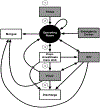The Cumulative Perioperative Model: Predicting 30-Day Mortality in Abdominal Surgery Cancer Patients
- PMID: 34632445
- PMCID: PMC8496410
- DOI: 10.31487/j.jso.2020.01.10
The Cumulative Perioperative Model: Predicting 30-Day Mortality in Abdominal Surgery Cancer Patients
Abstract
Objectives: 1) To develop a cumulative perioperative model (CPM) using the hospital clinical course of abdominal surgery cancer patients that predicts 30 and 90-day mortality risk; 2) To compare the predictive ability of this model to ten existing other models.
Materials and methods: We constructed a multivariate logistic regression model of 30 (90)-day mortality, which occurred in 106 (290) of the cases, using 13,877 major abdominal surgical cases performed at the University of Texas MD Anderson Cancer Center from January 2007 to March 2014. The model includes race, starting location (home, inpatient ward, intensive care unit or emergency center), Charlson Comorbidity Index, emergency status, ASA-PS classification, procedure, surgical Apgar score, destination after surgery (hospital ward location) and delayed intensive care unit admit within six days. We computed and compared the model mortality prediction ability (C-statistic) as we accumulated features over time.
Results: We were able to predict 30 (90)-day mortality with C-statistics from 0.70 (0.71) initially to 0.87 (0.84) within six days postoperatively.
Conclusion: We achieved a high level of model discrimination. The CPM enables a continuous cumulative assessment of the patient's mortality risk, which could then be used as a decision support aid regarding patient care and treatment, potentially resulting in improved outcomes, decreased costs and more informed decisions.
Keywords: Regression analysis; decision support techniques; mortality; perioperative period.
Conflict of interest statement
Conflicts of Interest The authors whose names are listed certify that they have no affiliations with or involvement in any organization or entity with any financial interest (such as honoraria; educational grants; participation in speakers’ bureaus; membership, employment, consultancies, stock ownership, or other equity interest; and expert testimony or patent-licensing arrangements), or non-financial interest (such as personal or professional relationships, affiliations, knowledge or beliefs) in the subject matter or materials discussed in this manuscript.
Figures




References
-
- Birkhead GS, Klompas M, Shah NR (2015) Uses of electronic health records for public health surveillance to advance public health. Annu Rev Public Health 36: 345–359. - PubMed
-
- Adler Milstein J, DesRoches CM, Kralovec P, Foster G, Worzala C et al. (2015) Electronic Health Record Adoption In US Hospitals: Progress Continues, But Challenges Persist. Health Aff (Millwood) 34: 2174–2180. - PubMed
-
- Charlson ME, Pompei P, Ales KL, MacKenzie CR (1987) A new method of classifying prognostic comorbidity in longitudinal studies: development and validation. J Chronic Dis 40: 373–383. - PubMed
-
- Arrigo RT, Kalanithi P, Cheng I, Alamin T, Carragee EJ et al. (2011) Charlson score is a robust predictor of 30-day complications following spinal metastasis surgery. Spine (Phila Pa 1976) 36: E1274–E1280. - PubMed
-
- Dekker JW, Gooiker GA, van der Geest LG, Kolfschoten NE, Struikmans H et al. (2012) Use of different comorbidity scores for risk-adjustment in the evaluation of quality of colorectal cancer surgery: does it matter? Eur J Surg Oncol 38: 1071–1078. - PubMed
Grants and funding
LinkOut - more resources
Full Text Sources
